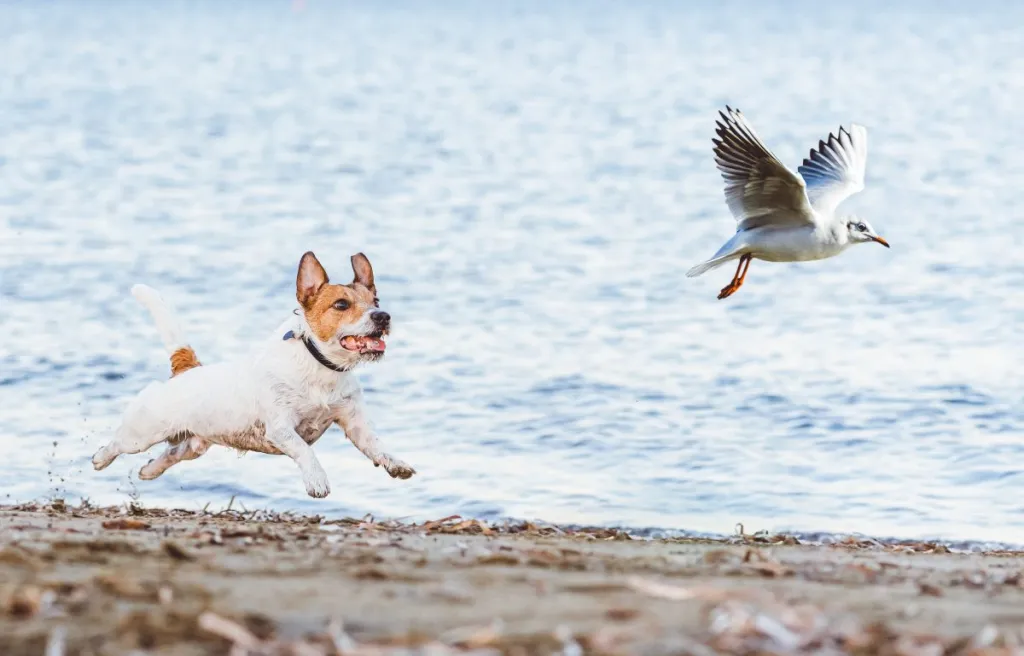Many working and hunting breeds of dogs were developed to help humans flush out, chase, and herd various animals. However, in everyday life prey drive can be a challenge to tackle if you live in an apartment or the city. Here are some ways how to manage prey drive in dogs.
Understand prey drive

Prey drive is an instinctual behavior. It’s what drives a dog to notice, chase, or capture prey. For working dogs, this may have been done through tasks such as flushing birds from a bush, baying at a fox, or herding sheep into a pen. This instinct can manifest in other ways such as herding small children around the house or chasing the family cat. Some breeds, such as Border Collies and German Shorthair Pointers, have a high natural prey drive. However, this drive can vary from dog to dog, even among high prey drive breeds.
Identify and avoid triggers
If you’ve noticed your dog has a high prey drive, you’ve probably also noticed what triggers it. Perhaps the neighborhood cat makes your dog want to chase it through the yard. Or, your dog herds the kids to the couch every time they get up. By watching your dog’s behavior, you can help pinpoint what these triggers are.
The best course of action to reduce prey drive and the potential for harm to other people and animals is by avoiding the trigger. Try techniques such as keeping your dog on a leash when outdoors. Or, fully enclose your yard with secure fencing, and move your dog to another room if they become too fixated on an object. This can help reduce the behavior and avoid accidentally reinforcing it.
Use distraction techniques to manage a high prey drive
Distraction can help reduce prey drive by redirecting your dog to a more positive behavior. The amount of distraction needed can vary. If you’re at home, redirecting your dog to a puzzle toy that engages their mind, or a game of fetch in the yard can help. For more active breeds, engaging in activities such as lure coursing or flyball can help them indulge their instincts in a safe, controlled environment.
Provide adequate exercise and mental stimulation
A bored dog is a destructive dog. It’s important to consider your dog’s physical and mental needs. By keeping your dog’s mind and body active, you can tire them out through constructive activities. Agility, dock jumping, frisbee, and more can all be great ways to stimulate your dog in a structured environment. At home, long walks or jogs that allow your dog to sniff or interact with the environment can also be beneficial. Just make sure your dog is fully secured on a leash in the event a small creature or bird is too enticing.
Train your dog
You can’t always avoid every single trigger, especially in highly motivated dogs. Training, in addition to taking steps to avoid the trigger, can help reduce issues. A good first step is to work on basic obedience training, either in a group class or one-on-one with a trainer. This will help improve communication between you and your dog, teach you to read your dog’s body language more easily, and help give you techniques to distract or deter your dog from getting overstimulated.
If your dog’s prey drive is too much to handle alone, consider seeking out a behaviorist. They can create a tailored plan to suit your dog’s needs. Desensitization can also help reduce behaviors, such as with BAT techniques and other distraction and deterrence training. While training can’t completely remove an instinctual behavior, it can help reduce escalation or overstimulation, making it easier to deter your dog away from the trigger.
Prey drive can be a frustrating behavior to deal with. However, following these steps can help you better understand and address your dog’s natural instincts. Now that you know some tips and tricks on how to help manage prey drive in your pet, learn more about which dog breeds have a high prey drive.









